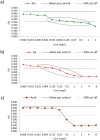Comparison of EUCAST and CLSI Reference Microdilution MICs of Eight Antifungal Compounds for Candida auris and Associated Tentative Epidemiological Cutoff Values
- PMID: 28416539
- PMCID: PMC5444165
- DOI: 10.1128/AAC.00485-17
Comparison of EUCAST and CLSI Reference Microdilution MICs of Eight Antifungal Compounds for Candida auris and Associated Tentative Epidemiological Cutoff Values
Abstract
Candida auris is an emerging multidrug-resistant yeast. So far, all but two susceptibility testing studies have examined ≤50 isolates, mostly with the CLSI method. We investigated CLSI and EUCAST MICs for 123 C. auris isolates and eight antifungals and evaluated various methods for epidemiological cutoff (ECOFF) determinations. MICs (in milligrams per liter) were determined using CLSI method M27-A3, and the EUCAST E.Def 7.3. ANOVA analysis of variance with Bonferroni's multiple-comparison test and Pearson analysis were used on log2 MICs (significance at P values of <0.05). The percent agreement (within ±0 to ±2 2-fold dilutions) between the methods was calculated. ECOFFs were determined visually, statistically (using the ECOFF Finder program and MicDat1.23 software with 95% to 99% endpoints), and via the derivatization method (dECOFFs). The CLSI and EUCAST MIC distributions were wide, with several peaks for all compounds except amphotericin B, suggesting possible acquired resistance. Modal MIC, geometric MIC, MIC50, and MIC90 values were ≤1 2-fold dilutions apart, and no significant differences were found. The quantitative agreement was best for amphotericin B (80%/97% within ±1/±2 dilutions) and lowest for isavuconazole and anidulafungin (58%/76% to 75% within ±1/±2 dilutions). We found that 90.2%/100% of the isolates were amphotericin B susceptible based on CLSI/EUCAST methods, respectively (i.e., with MICs of ≤1 mg/liter), and 100%/97.6% were fluconazole nonsusceptible by CLSI/EUCAST (MICs > 2). The ECOFFs (in milligrams per liter) were similar across the three different methods for itraconazole (ranges for CLSI/EUCAST, 0.25 to 0.5/0.5 to 1), posaconazole (0.125/0.125 to 0.25), amphotericin B (0.25 to 0.5/1 to 2), micafungin (0.25 to 0.5), and anidulafungin (0.25 to 0.5/0.25 to 1). In contrast, the estimated ECOFFs were dependent on the method applied for voriconazole (1 to 32) and isavuconazole (0.125 to 4). CLSI and EUCAST MICs were remarkably similar and confirmed uniform fluconazole resistance and variable acquired resistance to the other agents.
Keywords: Candida auris; ECOFF; MIC; amphotericin B; antifungal susceptibility testing; azoles; echinocandins; in vitro.
Copyright © 2017 American Society for Microbiology.
Figures

References
-
- Lockhart SR, Etienne KA, Vallabhaneni S, Farooqi J, Chowdhary A, Govender NP, Colombo AL, Calvo B, Cuomo CA, Desjardins CA, Berkow EL, Castanheira M, Magobo RE, Jabeen K, Asghar RJ, Meis JF, Jackson B, Chiller T, Litvintseva AP. 2017. Simultaneous emergence of multidrug-resistant Candida auris on 3 continents confirmed by whole-genome sequencing and epidemiological analyses. Clin Infect Dis 64:134–140. doi:10.1093/cid/ciw691. - DOI - PMC - PubMed
MeSH terms
Substances
LinkOut - more resources
Full Text Sources
Other Literature Sources

